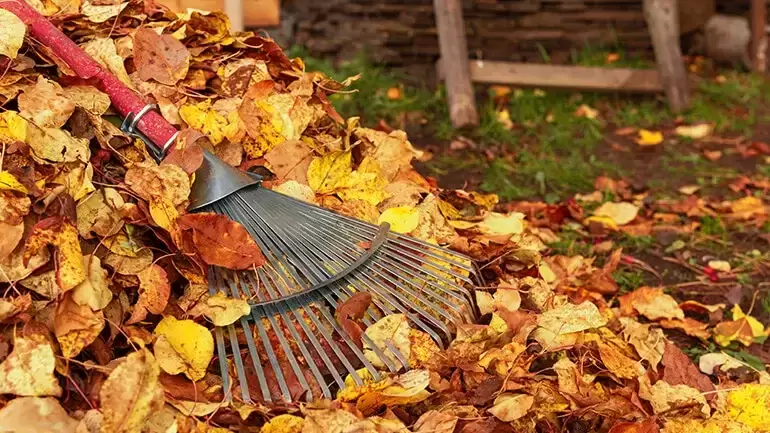10 TASKS TO DO AROUND THE GARDEN DURING AUTUMN
Date: 23 Mar 2024
Autumn is a season of both beauty and preparation. As the vibrant hues of changing leaves paint the landscape, it's also time to get your garden ready for the colder months ahead. Here are 10 essential tasks to ensure your outdoor haven thrives throughout winter and explodes with life come spring:
1. Embrace the Autumn Tidy Up
While breezy days might send leaves swirling in a seemingly never-ending cycle, resist the urge to see them as a nuisance. Fallen leaves are a valuable resource! Rake and add them to your compost heap. Decomposed leaves, also known as leaf mould, are a fantastic source of nutrients for your soil. They help suppress weeds, retain moisture, and improve overall soil structure.
If you don't have a compost bin yet, autumn is the perfect time to start one. With an abundance of leaves and plant cuttings at your disposal, you'll be well on your way to creating nutrient-rich compost for next season.
For those short on space, consider using leaf bags. These allow leaves to decompose neatly and can be easily added to your garden beds later. Just be sure to keep an eye out for hedgehogs or other small creatures that might find refuge in leaf piles before adding them to your compost bin.
2. Prioritise Weeding
Autumn presents a golden opportunity to gain control of pesky weeds. By pulling them out before they flower and set seed, you'll significantly reduce the number that germinate and take over your garden beds come spring.
3. Manage Fallen Leaves Strategically
While some leaf removal is beneficial, it's important not to go overboard. Regularly transfer fallen leaves from your lawn and garden beds to your compost bin. A thick layer of leaves left unattended can smother your plants and grass. Rake them up and use them for composting or as mulch around your garden beds. Well-rotted leaf mould is a treasure trove of nutrients and a valuable addition to your soil.
4. Cut Back Perennials with Care
Perennials that bloomed in spring can be trimmed back during autumn. However, leave a portion of the stem to mark where they are planted. This will prevent you from accidentally digging up established plants when adding new ones to your garden later.
5. Prune Hedges and Plants for a Bushier Look
Trimming hedges before winter helps maintain their shape and keeps them compact and bushy. Pruning also stimulates new growth. When you remove the terminal bud on a stem, it triggers the growth of buds lower down, resulting in a denser and bushier plant. However, be mindful not to prune everything back as you might miss out on spring blooms. Plants like Wisteria set their spring buds early, so be sure to identify and leave the flowering spurs to avoid sacrificing their beautiful display.
6. Prepare for Winter's Arrival
Autumn is the time to shield your plants and garden structures from the harsh realities of winter. Don't wait for the first frost to take you by surprise. Check fences, sheds, and gates for any signs of weakness or rot, and repair or replace them as necessary. Protect tender plants and borderline hardy potted plants from frost by insulating their containers with bubble wrap or fleece covers. If possible, move them to a greenhouse for added protection.
Remember to cover or store wooden garden furniture for the winter months. Terracotta pots are also susceptible to cracking in freezing temperatures, so bring them indoors to avoid damage.
7. Harvest the Bounty of the Season
Autumn is harvest time! Gather any remaining root vegetables, pumpkins, squash, and cool-weather greens that are ready. Pumpkins planted earlier can be harvested now and potentially last until Christmas with proper storage. Consider planting more pumpkins in succession throughout April, May, and June to extend your harvest window. Leftover pumpkins or pumpkin skins can be transformed into bird feeders – a resourceful and sustainable way to help our feathered friends.
8. Plant New Trees and Shrubs for Spring Glory
Autumn is an excellent time to plant new trees and shrubs, provided the soil is reasonably moist. This allows them to establish themselves before the hot summer months arrive. Before planting anything new, ensure the chosen location doesn't clash with underground services like sewage drains or power cables. If unsure, contact the relevant service provider to obtain a map of underground utilities on your property.
For optimal results, prepare the soil properly before planting. Clay soil benefits from the addition of gypsum to improve drainage. Regardless of your soil type, regularly adding organic matter such as composted manure, pelleted fertiliser, or compost is essential. This practice replenishes nutrients and feeds the soil microorganisms that play a crucial role in maintaining good soil structure and drainage, ultimately promoting healthy plant growth.
9. Propagate Plants from Cuttings
Many flowering perennials like sedum, cornflower (Echinacea), and ornamental grasses have beautiful seed heads in autumn. Consider leaving some of these on your plants for winter interest. They add a touch of texture and visual appeal to the garden during the colder months.
Rose enthusiasts might also consider leaving some flowers on their rose bushes to develop rose hips (red/orange berries). These not only look attractive but also help maintain the vigour of the rose plants.
10. Rejuvenate Your Lawn for a Lush Spring
Autumn is the perfect season to shower your lawn with some much-needed TLC. Aerate the soil to allow oxygen, water, and fertiliser to reach the grass roots, promoting a thicker and healthier lawn. You can achieve this by using a core aerator or spiking shoes.
After aeration, fertilise your lawn with a phosphorus-rich fertiliser. Phosphorus encourages root development and helps your lawn establish a strong foundation for winter and the following spring. Give your lawn its final mow at the end of October and leave it uncut until well into next year. Raising your mower blades slightly for the last cut allows the longer grass to protect the lawn from frost damage.
For best results, consider hiring a professional lawn care service. They have the expertise and equipment to ensure your lawn receives the proper care it needs to thrive throughout the year.
To wrap up,
By following these 10 essential tasks, you can ensure your garden transitions smoothly into autumn and emerges vibrant and flourishing come spring. Remember, a little effort invested now will reap significant rewards in the seasons to come. So, grab your gardening gloves, embrace the crisp autumn air, and get ready to transform your outdoor space!
Feeling overwhelmed by your autumn garden chores? Don't hesitate to seek help from the experts! Lawn Rite offers a comprehensive range of autumn garden maintenance services, from professional lawn care and hedge trimming to leaf removal and composting. Contact us today for a free quote and let them help you create a beautiful and healthy garden that thrives year-round!
Back...
